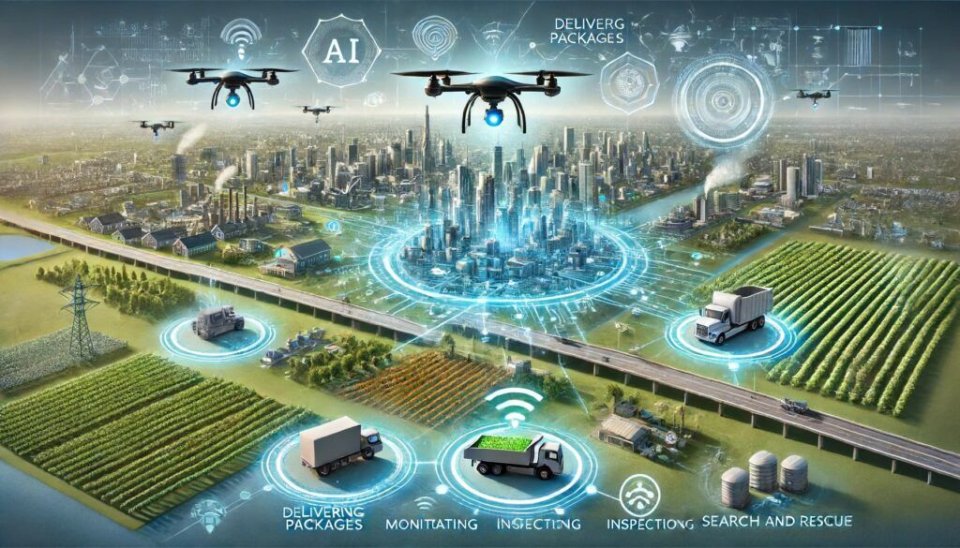Low-altitude flight routes have commenced operations across multiple regions, low-altitude economy industrial funds continue to materialise, and the number of enterprises within the industrial chain has grown significantly... Since the start of this year, China's low-altitude economy has demonstrated sustained vitality.
As an emerging economic model, China's low-altitude economy possesses immense market potential and a robust industrial chain foundation, while simultaneously facing numerous challenges spanning infrastructure, market dynamics, and technology. Overcoming these hurdles is pivotal to the sector's development.

Trillion-Yuan Low-Altitude Market Accelerates Takeoff
First included in the Government Work Report in 2024, the low-altitude economy has attracted multi-party competition over the past year. From central to local levels, it integrates national strategies upwards and aligns with market demands downwards, unlocking a trillion-yuan market.
Local governments are investing substantial funds. Currently, 30 provinces, autonomous regions, and municipalities have incorporated low-altitude economic development into their government work reports or issued relevant policies to accelerate the implementation of related projects. According to incomplete statistics, nearly 20 cities including Beijing, Guangzhou, Suzhou, and Wuhan have established special industrial funds to channel more social capital into the low-altitude economy sector.
Low-altitude industrial projects are being signed and implemented at a rapid pace. Taking Chengdu as an example, over half of the 151 newly signed projects in the first quarter involved new productive forces such as the low-altitude economy and commercial aerospace. Since May, multiple regions have launched low-altitude routes: Shenyang activated a drone blood transport route, Shanghai's central urban area opened a customised low-altitude sightseeing route, and Zhengzhou Airport Economic Zone commenced regular low-altitude logistics test flights...
Market scale and enterprise numbers are expanding rapidly. Industry forecasts project China's low-altitude economy market size to exceed RMB 670 billion in 2024, reaching RMB 1.5 trillion by 2025. Qichacha data reveals 89,000 domestic enterprises currently operate within this sector, with 11,700 registered in the first five months of this year alone – a 220% year-on-year increase surpassing last year's total registrations.
Financing activity in the low-altitude economy sector remains robust. IT Juzi data reveals 156 investment and financing events in this sector during 2024, with total funding reaching approximately 24.538 billion yuan – a 47.7% increase year-on-year. The first five months of this year alone saw 87 such events, marking a 50% rise compared to the same period last year.
‘Today's low-altitude economy scenarios are no longer mere “single-technology showcases”, but have genuinely penetrated industrial pain points and public needs,’ stated Fan Bangkui, Vice Chairman of the China Electronics Society. He noted that the continuous expansion of low-altitude economy applications stems from the concurrent advancement of technological maturity, policy support, and market acceptance.
Low-altitude economy still faces multiple challenges
Although China's low-altitude economy demonstrates immense potential through accelerated breakthroughs, numerous challenges remain in transitioning from ‘taking flight’ to ‘practical application.’ Experts note that China's low-altitude economic development still requires advancement in key core technologies, application scenario adoption rates, and management system construction.
Technologically, core technologies essential for low-altitude economic development remain unresolved.
‘The crux lies in achieving efficient and cost-effective operations,’ remarked Academician Xiang Jinwu of the Chinese Academy of Engineering. He highlighted that challenges primarily concern aircraft technologies suitable for low-altitude flight and airspace management systems, noting that power systems and onboard equipment still largely rely on imports.
‘The most pressing breakthrough needed is in battery endurance,’ Xie Haitian, Chairman of Beijing Dui Shi Yu Wu Technology Co., Ltd., told reporters. Currently, whether for heavy-lift drones or manned eVTOLs, endurance generally lasts only around half an hour, barely meeting the short-range flight needs of small all-electric aircraft.
Regarding market prospects, both application scenario penetration and commercial maturity require further enhancement.
Presently, China's low-altitude economy primarily serves agricultural crop protection, tourism sightseeing, short-distance delivery, medical emergency response, and firefighting operations, lacking mature and stable business models.
Zhang Xiaolan, Deputy Director of the Policy Simulation Laboratory at the Economic Forecasting Department of the National Information Centre and Associate Research Fellow, noted that application scenarios in China currently exhibit low penetration rates. General aviation is predominantly concentrated in industrial, agricultural, and public service sectors, accounting for over 80% of the market total, while business and private aviation constitute only around 18%, indicating untapped consumer potential.
Concurrently, interviewed experts emphasised that safety and controllability are paramount for low-altitude economic development. Addressing deficiencies in infrastructure and regulatory frameworks is imperative to comprehensively advance the secure and standardised growth of this sector.

Innovation-Driven Foundation Building and Application Expansion
Multiple industry experts emphasised the need to strengthen infrastructure support, broaden diverse application scenarios, and intensify core technological breakthroughs to further promote the healthy and orderly development of the low-altitude economy.
With advancements in drone technology, new energy propulsion, BeiDou navigation, 5G communications, and artificial intelligence, the era of intelligent low-altitude transportation is rapidly approaching. Xiang Jinwu contends that the low-altitude economy will be dominated by drones and underpinned by intelligent low-altitude networks. He advocates vigorously developing new intelligent low-altitude infrastructure by constructing ‘sky roads,’ building ‘sky networks,’ and creating ‘sky vehicles.’
‘Promoting diversified transformation of low-altitude economic application scenarios,’ stated Fan Bangkui, requires accelerating the formation of networked, digitalised, intelligent, and service-oriented aerial flight infrastructure. Technologically, we must transcend single-purpose transport applications by deeply integrating with sectors such as urban governance, emergency response, and geographic surveying to establish a comprehensive, multi-dimensional low-altitude service network.
Technological innovation serves as the engine driving industrial advancement. Guided by technological innovation, accelerating the transformation of scientific achievements and promoting deep integration between innovation chains and industrial chains are pivotal to the development of the low-altitude economy.
Zhang Xiaolan believes it is essential to establish a comprehensive innovation ecosystem encompassing ‘basic research + technological breakthroughs + industrialisation of outcomes.’ This should focus on tackling key components and core systems, guiding enterprises to strengthen collaboration with universities and research institutes, and enhancing the supply of technological innovation resources and the conversion of outcomes.
Wei Zhiqiang, Deputy Dean of the Air Traffic Management College at the Civil Aviation University of China, advocates accelerating the development of pilot production platforms. Through government guidance and sustained capital investment, efforts should concentrate on bridging the gap between university research outcomes and corporate needs.
‘Intelligence and safety will form the twin pillars of low-altitude economic development,’ asserts Huang Yuhong, Director of China Mobile Research Institute. At this pivotal stage where the low-altitude economy is poised for takeoff, safety and controllability alongside intelligent infrastructure become core imperatives for industrial advancement. Building a highly secure and reliable low-altitude intelligent network is essential to empower the healthy development of this sector.